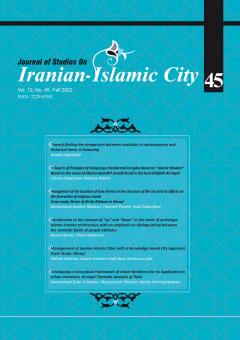In Search of Principles of Designing a Residential Complex Based on “Islamic Wisdom” (Based on the views of Allama Ayatollah Javadi Amoli in the book Mafatih Al-Hayat)
Subject Areas : Basic concepts in Islamic urban planning and architecture
salman noghrekar
1
![]() ,
reyhaneh rahimi
2
,
reyhaneh rahimi
2
1 - Assistant Professor, Faculty of Architecture and Urban Planning, Shahid Rajaee Teacher Training University
2 - Master of Architecture, Faculty of Architecture and Art, Kashan University.
Keywords: Islamic housing, Islamic life style, the four human relationships, Residential complex, Javadi Amoli, The keys of life, Architecture training,
Abstract :
Without a proper definition of the right way of “living”, we can not talk about the good form of “housing” and the desired quality of “living space”. The research hypothesis is that “living container” and “lifestyle” have a reciprocal effect. Man’s life includes his fourfold relationship with “God, self, others and nature”, which, if based on Islamic teachings, can be said to have been achieved by the Muslim way of life. And “architecture” has the attribute of “Islamic” to the extent that it facilitates it. The aim of this research is to achieve principles for such “architecture” on the scale of “residential complex”. The research question is “What principles should we follow in designing a residential complex that lays the groundwork for an Islamic lifestyle?” To find the answer On the one hand, during conceptual modeling, nine key components of a residential complex were explained. Then, during library studies and content analysis methods, different approaches to “Islamic housing” were categorized and analyzed in two ways: “quantitative and qualitative”. From the third path, the characteristics of the Islamic way of life were obtained from the point of view of Allameh Javadi Ameli - as an Islamologist based on research; accordingly, the residential complex includes four main areas: “housing, roads, service space and green and open space”. The result of the research is the achievement of “design rules” of each of these nine elements that make up the residential complex, which is expressed in the form of “negative and positive principles”. In the current situation of the country, where due to the people’s need for housing, the policy of the “National Housing Production Movement” has been proposed by managers, the achievement of this research can be the guiding principles in designing a residential complex for designers. It should also be a basis for teaching architecture and training architects, especially in the course “Residential Complex Design” (Design 5).
